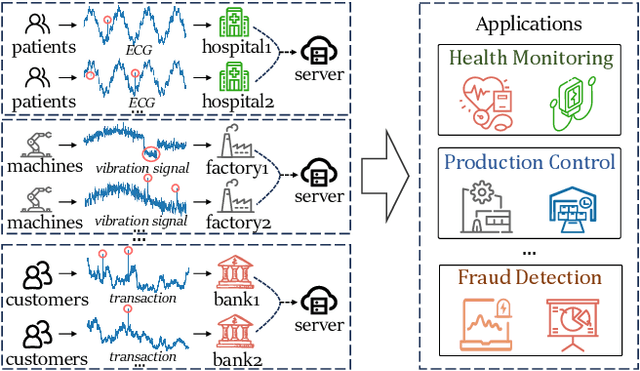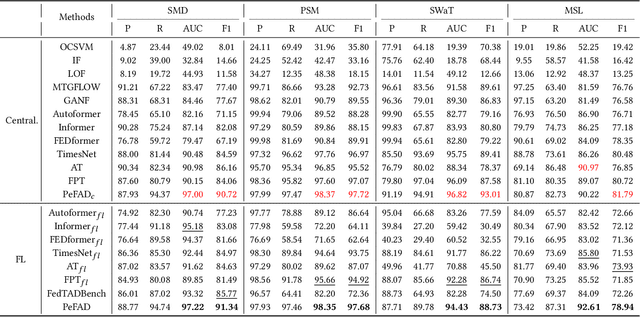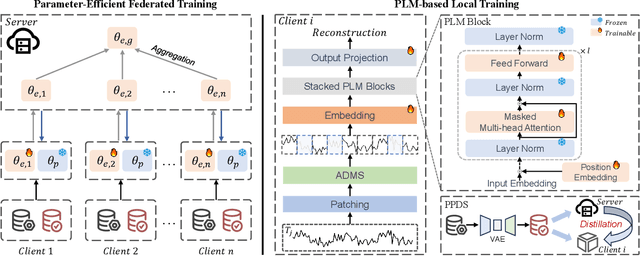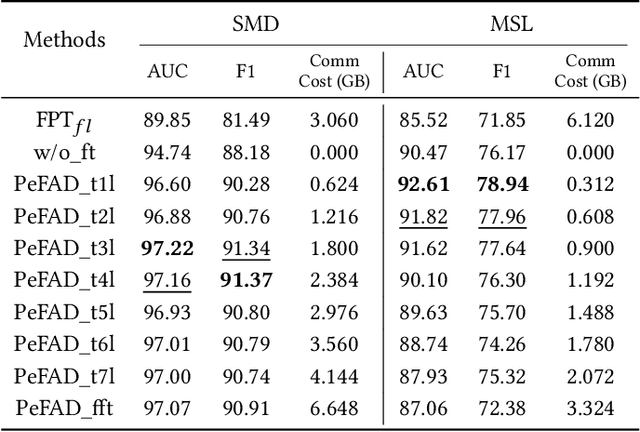Hao Miao
TimeEmb: A Lightweight Static-Dynamic Disentanglement Framework for Time Series Forecasting
Oct 01, 2025Abstract:Temporal non-stationarity, the phenomenon that time series distributions change over time, poses fundamental challenges to reliable time series forecasting. Intuitively, the complex time series can be decomposed into two factors, \ie time-invariant and time-varying components, which indicate static and dynamic patterns, respectively. Nonetheless, existing methods often conflate the time-varying and time-invariant components, and jointly learn the combined long-term patterns and short-term fluctuations, leading to suboptimal performance facing distribution shifts. To address this issue, we initiatively propose a lightweight static-dynamic decomposition framework, TimeEmb, for time series forecasting. TimeEmb innovatively separates time series into two complementary components: (1) time-invariant component, captured by a novel global embedding module that learns persistent representations across time series, and (2) time-varying component, processed by an efficient frequency-domain filtering mechanism inspired by full-spectrum analysis in signal processing. Experiments on real-world datasets demonstrate that TimeEmb outperforms state-of-the-art baselines and requires fewer computational resources. We conduct comprehensive quantitative and qualitative analyses to verify the efficacy of static-dynamic disentanglement. This lightweight framework can also improve existing time-series forecasting methods with simple integration. To ease reproducibility, the code is available at https://github.com/showmeon/TimeEmb.
STRAP: Spatio-Temporal Pattern Retrieval for Out-of-Distribution Generalization
May 26, 2025Abstract:Spatio-Temporal Graph Neural Networks (STGNNs) have emerged as a powerful tool for modeling dynamic graph-structured data across diverse domains. However, they often fail to generalize in Spatio-Temporal Out-of-Distribution (STOOD) scenarios, where both temporal dynamics and spatial structures evolve beyond the training distribution. To address this problem, we propose an innovative Spatio-Temporal Retrieval-Augmented Pattern Learning framework,STRAP, which enhances model generalization by integrating retrieval-augmented learning into the STGNN continue learning pipeline. The core of STRAP is a compact and expressive pattern library that stores representative spatio-temporal patterns enriched with historical, structural, and semantic information, which is obtained and optimized during the training phase. During inference, STRAP retrieves relevant patterns from this library based on similarity to the current input and injects them into the model via a plug-and-play prompting mechanism. This not only strengthens spatio-temporal representations but also mitigates catastrophic forgetting. Moreover, STRAP introduces a knowledge-balancing objective to harmonize new information with retrieved knowledge. Extensive experiments across multiple real-world streaming graph datasets show that STRAP consistently outperforms state-of-the-art STGNN baselines on STOOD tasks, demonstrating its robustness, adaptability, and strong generalization capability without task-specific fine-tuning.
Towards Cross-Modality Modeling for Time Series Analytics: A Survey in the LLM Era
May 05, 2025Abstract:The proliferation of edge devices has generated an unprecedented volume of time series data across different domains, motivating various well-customized methods. Recently, Large Language Models (LLMs) have emerged as a new paradigm for time series analytics by leveraging the shared sequential nature of textual data and time series. However, a fundamental cross-modality gap between time series and LLMs exists, as LLMs are pre-trained on textual corpora and are not inherently optimized for time series. Many recent proposals are designed to address this issue. In this survey, we provide an up-to-date overview of LLMs-based cross-modality modeling for time series analytics. We first introduce a taxonomy that classifies existing approaches into four groups based on the type of textual data employed for time series modeling. We then summarize key cross-modality strategies, e.g., alignment and fusion, and discuss their applications across a range of downstream tasks. Furthermore, we conduct experiments on multimodal datasets from different application domains to investigate effective combinations of textual data and cross-modality strategies for enhancing time series analytics. Finally, we suggest several promising directions for future research. This survey is designed for a range of professionals, researchers, and practitioners interested in LLM-based time series modeling.
Efficient Multivariate Time Series Forecasting via Calibrated Language Models with Privileged Knowledge Distillation
May 04, 2025Abstract:Multivariate time series forecasting (MTSF) endeavors to predict future observations given historical data, playing a crucial role in time series data management systems. With advancements in large language models (LLMs), recent studies employ textual prompt tuning to infuse the knowledge of LLMs into MTSF. However, the deployment of LLMs often suffers from low efficiency during the inference phase. To address this problem, we introduce TimeKD, an efficient MTSF framework that leverages the calibrated language models and privileged knowledge distillation. TimeKD aims to generate high-quality future representations from the proposed cross-modality teacher model and cultivate an effective student model. The cross-modality teacher model adopts calibrated language models (CLMs) with ground truth prompts, motivated by the paradigm of Learning Under Privileged Information (LUPI). In addition, we design a subtractive cross attention (SCA) mechanism to refine these representations. To cultivate an effective student model, we propose an innovative privileged knowledge distillation (PKD) mechanism including correlation and feature distillation. PKD enables the student to replicate the teacher's behavior while minimizing their output discrepancy. Extensive experiments on real data offer insight into the effectiveness, efficiency, and scalability of the proposed TimeKD.
C2F-TP: A Coarse-to-Fine Denoising Framework for Uncertainty-Aware Trajectory Prediction
Dec 17, 2024Abstract:Accurately predicting the trajectory of vehicles is critically important for ensuring safety and reliability in autonomous driving. Although considerable research efforts have been made recently, the inherent trajectory uncertainty caused by various factors including the dynamic driving intends and the diverse driving scenarios still poses significant challenges to accurate trajectory prediction. To address this issue, we propose C2F-TP, a coarse-to-fine denoising framework for uncertainty-aware vehicle trajectory prediction. C2F-TP features an innovative two-stage coarse-to-fine prediction process. Specifically, in the spatial-temporal interaction stage, we propose a spatial-temporal interaction module to capture the inter-vehicle interactions and learn a multimodal trajectory distribution, from which a certain number of noisy trajectories are sampled. Next, in the trajectory refinement stage, we design a conditional denoising model to reduce the uncertainty of the sampled trajectories through a step-wise denoising operation. Extensive experiments are conducted on two real datasets NGSIM and highD that are widely adopted in trajectory prediction. The result demonstrates the effectiveness of our proposal.
Unsupervised Time Series Anomaly Prediction with Importance-based Generative Contrastive Learning
Oct 22, 2024



Abstract:Time series anomaly prediction plays an essential role in many real-world scenarios, such as environmental prevention and prompt maintenance of cyber-physical systems. However, existing time series anomaly prediction methods mainly require supervised training with plenty of manually labeled data, which are difficult to obtain in practice. Besides, unseen anomalies can occur during inference, which could differ from the labeled training data and make these models fail to predict such new anomalies. In this paper, we study a novel problem of unsupervised time series anomaly prediction. We provide a theoretical analysis and propose Importance-based Generative Contrastive Learning (IGCL) to address the aforementioned problems. IGCL distinguishes between normal and anomaly precursors, which are generated by our anomaly precursor pattern generation module. To address the efficiency issues caused by the potential complex anomaly precursor combinations, we propose a memory bank with importance-based scores to adaptively store representative anomaly precursors and generate more complicated anomaly precursors. Extensive experiments on seven benchmark datasets show our method outperforms state-of-the-art baselines on unsupervised time series anomaly prediction problems.
BSG4Bot: Efficient Bot Detection based on Biased Heterogeneous Subgraphs
Oct 07, 2024



Abstract:The detection of malicious social bots has become a crucial task, as bots can be easily deployed and manipulated to spread disinformation, promote conspiracy messages, and more. Most existing approaches utilize graph neural networks (GNNs)to capture both user profle and structural features,achieving promising progress. However, they still face limitations including the expensive training on large underlying graph, the performance degration when similar neighborhood patterns' assumption preferred by GNNs is not satisfied, and the dynamic features of bots in a highly adversarial context. Motivated by these limitations, this paper proposes a method named BSG4Bot with an intuition that GNNs training on Biased SubGraphs can improve both performance and time/space efficiency in bot detection. Specifically, BSG4Bot first pre-trains a classifier on node features efficiently to define the node similarities, and constructs biased subgraphs by combining the similarities computed by the pre-trained classifier and the node importances computed by Personalized PageRank (PPR scores). BSG4Bot then introduces a heterogeneous GNN over the constructed subgraphs to detect bots effectively and efficiently. The relatively stable features, including the content category and temporal activity features, are explored and incorporated into BSG4Bot after preliminary verification on sample data. The extensive experimental studies show that BSG4Bot outperforms the state-of-the-art bot detection methods, while only needing nearly 1/5 training time.
PeFAD: A Parameter-Efficient Federated Framework for Time Series Anomaly Detection
Jun 04, 2024



Abstract:With the proliferation of mobile sensing techniques, huge amounts of time series data are generated and accumulated in various domains, fueling plenty of real-world applications. In this setting, time series anomaly detection is practically important. It endeavors to identify deviant samples from the normal sample distribution in time series. Existing approaches generally assume that all the time series is available at a central location. However, we are witnessing the decentralized collection of time series due to the deployment of various edge devices. To bridge the gap between the decentralized time series data and the centralized anomaly detection algorithms, we propose a Parameter-efficient Federated Anomaly Detection framework named PeFAD with the increasing privacy concerns. PeFAD for the first time employs the pre-trained language model (PLM) as the body of the client's local model, which can benefit from its cross-modality knowledge transfer capability. To reduce the communication overhead and local model adaptation cost, we propose a parameter-efficient federated training module such that clients only need to fine-tune small-scale parameters and transmit them to the server for update. PeFAD utilizes a novel anomaly-driven mask selection strategy to mitigate the impact of neglected anomalies during training. A knowledge distillation operation on a synthetic privacy-preserving dataset that is shared by all the clients is also proposed to address the data heterogeneity issue across clients. We conduct extensive evaluations on four real datasets, where PeFAD outperforms existing state-of-the-art baselines by up to 28.74\%.
TimeCMA: Towards LLM-Empowered Time Series Forecasting via Cross-Modality Alignment
Jun 03, 2024Abstract:The widespread adoption of scalable mobile sensing has led to large amounts of time series data for real-world applications. A fundamental application is multivariate time series forecasting (MTSF), which aims to predict future time series values based on historical observations. Existing MTSF methods suffer from limited parameterization and small-scale training data. Recently, Large language models (LLMs) have been introduced in time series, which achieve promising forecasting performance but incur heavy computational costs. To solve these challenges, we propose TimeCMA, an LLM-empowered framework for time series forecasting with cross-modality alignment. We design a dual-modality encoding module with two branches, where the time series encoding branch extracts relatively low-quality yet pure embeddings of time series through an inverted Transformer. In addition, the LLM-empowered encoding branch wraps the same time series as prompts to obtain high-quality yet entangled prompt embeddings via a Pre-trained LLM. Then, we design a cross-modality alignment module to retrieve high-quality and pure time series embeddings from the prompt embeddings. Moreover, we develop a time series forecasting module to decode the aligned embeddings while capturing dependencies among multiple variables for forecasting. Notably, we tailor the prompt to encode sufficient temporal information into a last token and design the last token embedding storage to reduce computational costs. Extensive experiments on real data offer insight into the accuracy and efficiency of the proposed framework.
LightTR: A Lightweight Framework for Federated Trajectory Recovery
May 06, 2024



Abstract:With the proliferation of GPS-equipped edge devices, huge trajectory data is generated and accumulated in various domains, motivating a variety of urban applications. Due to the limited acquisition capabilities of edge devices, a lot of trajectories are recorded at a low sampling rate, which may lead to the effectiveness drop of urban applications. We aim to recover a high-sampled trajectory based on the low-sampled trajectory in free space, i.e., without road network information, to enhance the usability of trajectory data and support urban applications more effectively. Recent proposals targeting trajectory recovery often assume that trajectories are available at a central location, which fail to handle the decentralized trajectories and hurt privacy. To bridge the gap between decentralized training and trajectory recovery, we propose a lightweight framework, LightTR, for federated trajectory recovery based on a client-server architecture, while keeping the data decentralized and private in each client/platform center (e.g., each data center of a company). Specifically, considering the limited processing capabilities of edge devices, LightTR encompasses a light local trajectory embedding module that offers improved computational efficiency without compromising its feature extraction capabilities. LightTR also features a meta-knowledge enhanced local-global training scheme to reduce communication costs between the server and clients and thus further offer efficiency improvement. Extensive experiments demonstrate the effectiveness and efficiency of the proposed framework.
 Add to Chrome
Add to Chrome Add to Firefox
Add to Firefox Add to Edge
Add to Edge